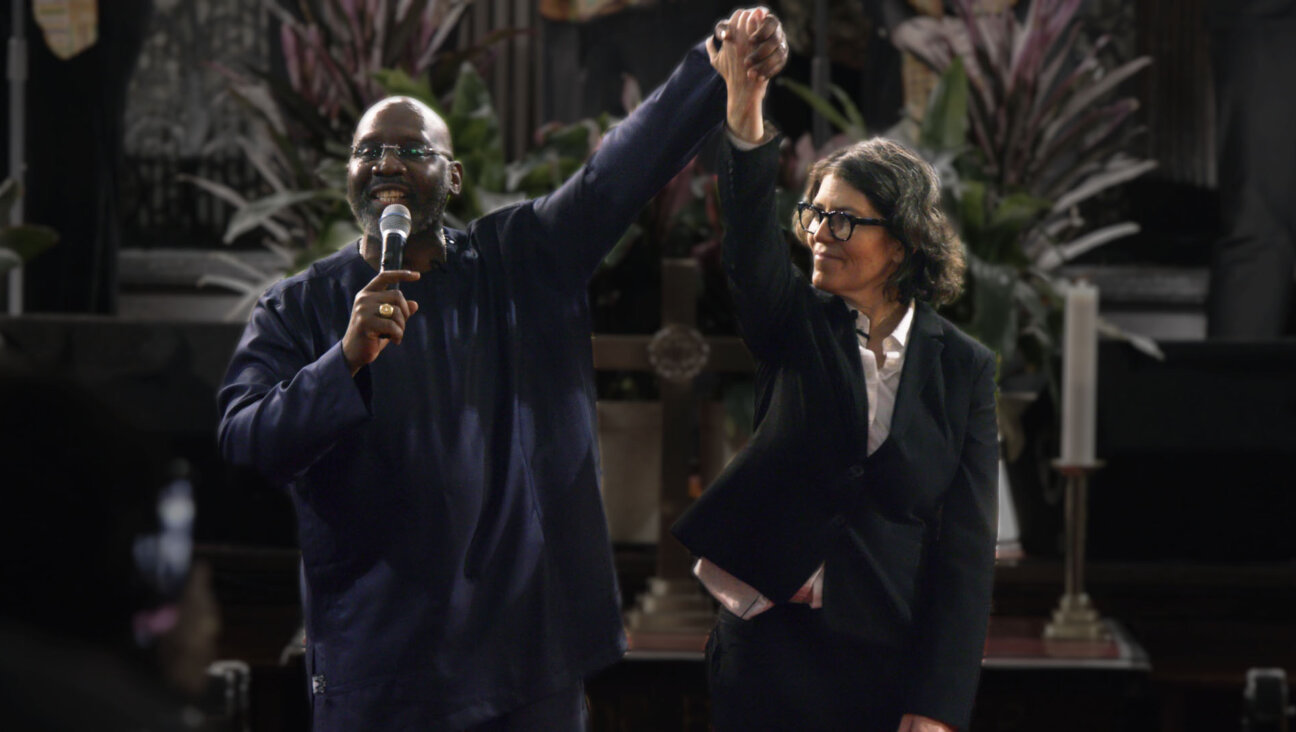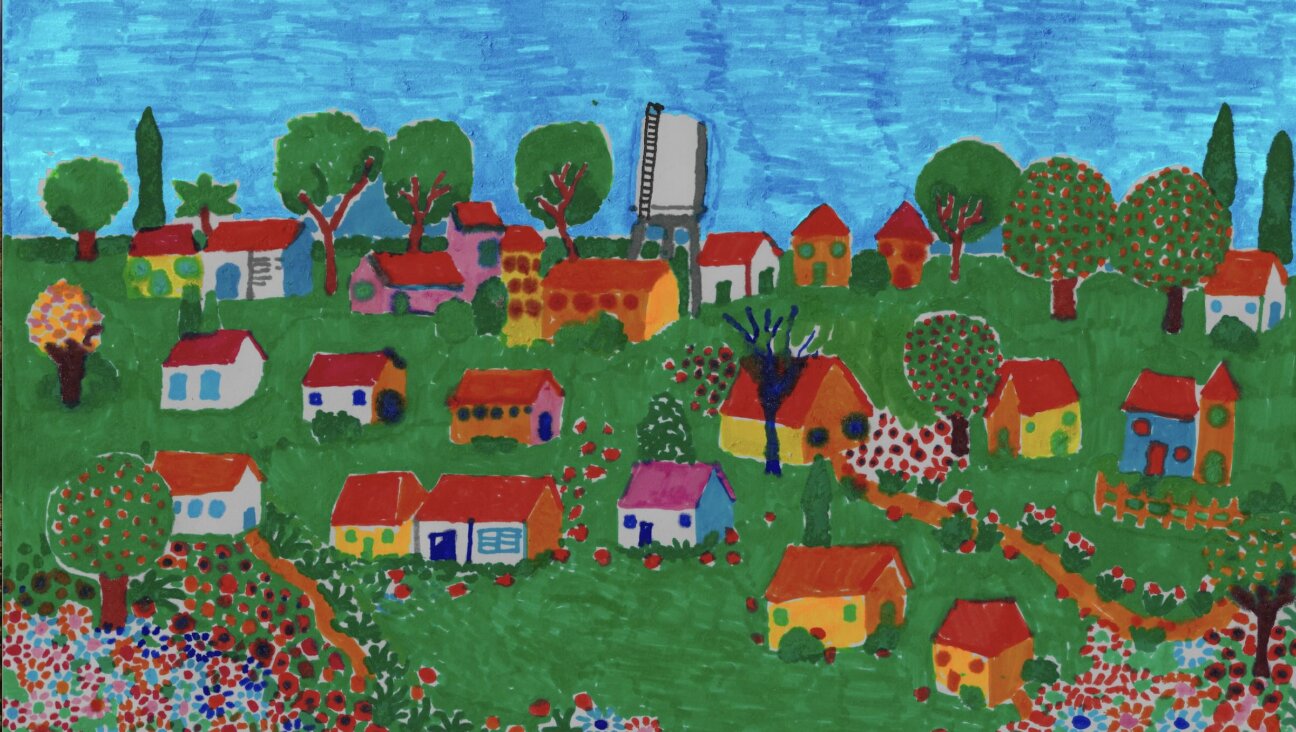‘The Best Hope For Yiddish is in Israel:’ An Interview With Scholar Avrom Nowerstern

Image by Bella Bryks-Klein
The following article originally appeared in the Yiddish Forverts. It was translated from the Yiddish by Meena Viswanath.
Dr. Avrom Nowerstern, the long-standing Yiddish teacher and researcher, is the director of Beth Shalom Aleichem in Tel Aviv. He was born in Argentina in 1951 and moved to Israel in 1969.
Nowerstern is no newcomer to the world of Yiddish, and yet he has been in the news lately. His comprehensive book on Yiddish literature in America was recently published, and it was just announced that he has won the Mifal Hapais “Landau Prize,” awarded annually in recognition of significant achievement in Israeli culture in the fields of arts and sciences.
Benny Mer: Your recent book, “Kan Gar Ha’am Hayehudi” (Here Lives the Jewish People) is dedicated to Yiddish literature in America, and is written in Hebrew. This seems to reflect at least three quarters of your identity.
Avrom Nowerstern: The truth is that this book should have been published in Yiddish. I mean that as I wrote the various chapters of the book – several of them in Yiddish – I engaged the leaders of Yiddish literary criticism in conversation: Shmuel Niger, B. Rivkin, Yankev Glatshteyn, and others with whom I may not have agreed. One could even call it a dialogue.
You pay a steep price when you write about Yiddish in Hebrew or in English. I call it “writing between commas.” When I write in Yiddish, and mention, for example, Moyshe Kulbak, I don’t need to explain who he was. But when I write in Hebrew or in English, I have to say “Moyshe Kulbak, the famous Yiddish writer of poetry and prose, who lived in Vilna, Berlin, and Minsk.” I have to add commas and notes that would be unnecessary for the Yiddish reader.
Unfortunately, we find ourselves in a time where writing in Yiddish is utopian. So I would say that Hebrew is the next-best language in which to write about Yiddish literature, because some of the Hebrew readers still have that common intellectual foundation which can bring them into the Yiddish world.
If only Di Goldene Keyt were still being published, I would say that that publication would have been the natural place to print such research articles, although I don’t kid myself – I know that the usual reader of Di Goldene Keyt wouldn’t have been used to such literary research articles. But despite that, I could have had the illusion that I was building upon a shared foundation between the writer and the reader – a foundation that today is nearly gone.
Is that why you chose, years ago, to deal with Yiddish in Hebrew, and specifically in Israel?
The awareness that our only hope is in Israel and in Hebrew came to me slowly. I grew up in an almost Bundist home. My parents used to save all the issues of the monthly magazine Undzer Tsayt, which was published in New York. I used to read them when I was around ten years old, and the whole anti-Zionist stance of the magazine affected me deeply. On the other hand, I went to the Sholem Aleichem school, which was a Zionist school.
My full awakening came when I read two books, not especially weighty or “ideological” books. One was Jacob Lestschinsky’s “Dos Natsyonale Ponem fun Goles-Yidntum” (“The National Profile of Diaspora Jewry”), where he demonstrated that Yiddish specifically and secular Judaism in general don’t have any chance of surviving in the Diaspora. I can quote from that book almost by heart. Another book which had an influence on me was Shloyme Saymen’s “Tokh Yidishkeyt” (“The Essence of Yidishkayt”), where he doesn’t foresee any opportunity for the spiritual continuation of secular Judaism, and therefore suggests reverting to halachic Judaism.
I tried several times to go to synagogue before realizing that it wasn’t for me. So the only option was Israel. Twenty years prior, and in vastly different circumstances, many Yiddish writers took that same path as an escape after the Holocaust, realizing that if they wanted to create something meaningful in Yiddish, it would have to be in Israel.
You prefaced your book with a motto of Abraham Sutzkever: “What’s burning so late at night? What’s burning, you can bet, is the emptiness in New York, without a Yiddish poet” [translation by David Roskies]. That is, you decided to start with the end?
Our perspective, whether we want it or not, is the perspective of what has ended. But I also mentioned Sutzkever because he had a close connection with a lot of American Yiddish writers. In the long conversations that I had with him, he was always telling me stories and even gossip about these writers. And that gave them another dimension for me, that in addition to being familiar with their literary texts, I got to peer into the lives of these writers as human beings.
But this isn’t your only book that deals with the end, or with awareness of the end. “Kesem Hadimdumim” (“The Magic of Twilight”), and your doctorate about Dovid Bergelson and others, also have similar aspects.
There’s a psychological aspect to it. Since I was twelve years old, I’ve lived with the angst of a sinking Yiddish, that something that we love and cherish has no chance to live on. And this dual feeling, of love and angst, also pushed me towards Yiddish. I never accepted the optimistic superficial declaration that Yiddish would live forever and so forth – the opposite, in fact.
But it’s not just psychological. The more you think about the foundational texts of Yiddish literature, the more you see that they were permeated with such a feeling of ending. Y.L. Peretz’s “Bay Nakht Afn Altn Mark” (“A Night in the Old Marketplace”) and Moyshe Leyb Halpern’s “A Nakht” (“A Night”), the poems of the young Glatshteyn, and so forth – the motif of the end suffuses Yiddish literature after Peretz, even beyond the Holocaust literature.
Maybe it was this awareness of the end that drove Yiddish writers and activists, including you, to such activism?
One of Sutzkever’s contrarian lines is: “Because you despise them, you want them to please” (from “When Eternity Weeps with Delight,” translation by Ruth Whitman). That is, living with the awareness that the end hovered so near made us always want to display a sort of liveliness. That exact struggle became a creative challenge for the best Yiddish writers. You can see in their work that this theme pushed them to write. The atmosphere in the European literature about “the twilight of humanity” became intertwined with this feeling of the fate of our language. The tension was especially clear when speaking about Yiddish and Hebrew, because Hebrew meant life and activity, and Yiddish – judgment, tragedy.
Did you struggle with this in Israel too?
I think I made peace with that destiny here, in Israel. I came wanting to dedicate my whole life to Yiddish. It’s been clear to me since I was thirteen or fourteen years old that this is what I want to do. And I knew even then that the largest Yiddish collections are in Jerusalem, and there is a Yiddish department in Hebrew University. The connection between Yiddish and Jerusalem was clear to me.
Chaim Boaz has a story about how he came from Vilna to America and brought along a chest of books. When I arrived in Israel, I brought along around twenty Yiddish books, which I thought represented the breadth of Yiddish poetry. I used to page through the books and read a page here, a page there, but one book stuck in my craw: Menachem Boreysho’s “Der Geyer” (“The Walker”), a poem of over 500 pages. I knew that it was an important poem, but I was never able to gather the strength to read it.
When I wrote this book about American Yiddish literature, I understood that if I were never to bite the bullet, the book would not be whole. So I added a chapter about “Der Geyer” after the manuscript was already at the publisher, and with that, I closed the circle. I tried, in this book, to analyze all the meaningful genres in American Yiddish literature: The short lyric poem, the serialized novel like Isaac Bashevis Singer’s “Di Familye Mushkat” (“The Family Moskat”), the canonical longer poem, the drama and the melodrama, and this sizable book was missing from the picture.
Sutzkever himself, whom you knew well and extensively researched, did not believe in the end of Yiddish. Again and again, and indeed in his last poems, he wrote of a Yiddish resurrection of sorts.
I’ll mention one thing here. It was issue #140 of Di Goldene Keyt. Sutzkever had told me that it was going to be the last issue. I had prepared an article about Leyeles’s poem “Tsu Dir Tsu Mir” (“To You To Me”) for that issue, and I had added an introduction that, especially for the last issue, I was writing an article about a poem that embodied the heyday of Yiddish literature. Sutzkever didn’t publish that introduction, and he wound up publishing another issue. It turns out that Sutzkever, just like everyone else, somehow couldn’t accept that everything has to end at some point.
One could say that you yourself struggled with the end. Eighteen years ago, you became a director of Beth Shalom Aleichem, which today is one of the busiest Yiddish institutions. This year, for example, you have 500 students in the various Yiddish classes.
In one seminar that I led together with David Roskies, I told the students that Yiddish, for me, is always connected with a feeling of ending, but those very students refute that connection. There is some hope. Maybe something can still happen – in a totally different configuration, of course. Yiddish is becoming the language of a select few, and not the masses.
What I want to do with Beth Shalom Aleichem is stimulate everything having to do with Yiddish that has value. A good show in Yiddish, a good course, and so forth. We rescue physical Yiddish books, we run joint programs with the National Library in Jerusalem and now with the National Yiddish Book Center [in Amherst] to scan books and newspapers, and I hope that in several years, not long from now, we will be in the situation that everyone will have access to the whole wealth of Yiddish literature.
Besides that, we have put a lot of effort into the “Indeks tsu der Yidisher Prese” (“Index to the Yiddish Press”). And so, in a generation from now, we will at least have a key to the treasures of Yiddish. We need to work on all fronts – for those select few and also for a wider audience – and hope that something will come of all of this.
Aaron Lansky wrote in his book “Outwitting History” that one of the most important endeavors today is translating Yiddish literature into other languages. What do you think?
Translations have their value, and many people come back to the original because of a good translation, but the problem is that translations go out of date quickly. Today, with so many tumultuous changes in every language, it happens even more quickly. The original text, in contrast, remains unchanged.
The State of Israel, since the times of Ben Gurion, has never been an easy place for a Yiddishist. Yiddish writers went around for years with bitter complaints against the state about being wronged. These complaints were justified, but they don’t paint the entire picture. The fact is that Sutzkever was successful in maintaining Di Goldene Keyt for fifty years. If other factions of the Yiddish culture had had such personalities, they might have brought more prestige to Yiddish.
Nowadays, Israel supports all sorts of cultural identities, yet we have a Minister of Culture, Miri Regev, who is not a big fan of Yiddish.
We need to think about a mosaic, and I think that the demands of these Mizrahi groups who are proud of their culture can be construed as a challenge to other groups. In this sense, both positively and negatively, Israel is the best place for Yiddish work. Especially because our land is small, Yiddish projects can have a deeper resonance than, for example, in America, where each project is a drop in the ocean. We roll up our sleeves and work on several fronts. One of the keys to our work is the desire not to serve ourselves, but to create joint projects with other institutions. We know and we believe that together, we are stronger.
Benny Mer, who frequently writes for the Forverts, is a literary critic for Haaretz.
A message from our Publisher & CEO Rachel Fishman Feddersen

I hope you appreciated this article. Before you go, I’d like to ask you to please support the Forward’s award-winning, nonprofit journalism during this critical time.
We’ve set a goal to raise $260,000 by December 31. That’s an ambitious goal, but one that will give us the resources we need to invest in the high quality news, opinion, analysis and cultural coverage that isn’t available anywhere else.
If you feel inspired to make an impact, now is the time to give something back. Join us as a member at your most generous level.
— Rachel Fishman Feddersen, Publisher and CEO























